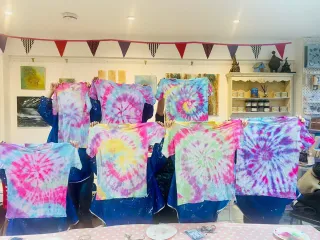Navigating the Tightrope: Balancing Business Growth and Personal Wellness

Running a small business can often feel like juggling flaming chainsaws on a tightrope, especially when you're passionate about both your work and personal well-being. As small business owners, particularly in creative industries, the line between business growth and personal wellness is often blurred, leaving us to navigate a complex landscape filled with small business struggles alongside the pressures of daily life. Have you ever felt like you're giving more than you're getting back, pouring your heart into a venture that seems to drain more than it fills? You're not alone! In this post, we'll explore how to find balance, drawing on creative community support and sharing insights on coping with burnout. Let's embark on this journey together, discovering ways to reignite the joy that inspired your business in the first place!
Balancing Business and Wellness
As small business owners, we often find ourselves walking a tightrope between nurturing our ventures and maintaining our personal well-being. This delicate balance is crucial for long-term success and happiness. Let's explore the challenges and strategies for achieving equilibrium in our professional and personal lives.
Facing Small Business Struggles
Running a small business comes with its unique set of challenges. From financial pressures to time management issues, these struggles can take a toll on our mental and physical health.
One of the most common hurdles is financial instability. The feast-or-famine cycle of income can create stress and uncertainty, especially in the early stages of business growth.
Time management is another significant challenge. Wearing multiple hats and juggling various responsibilities can lead to long work hours and difficulty in setting boundaries between work and personal life.
Lastly, the pressure to constantly innovate and stay ahead of the competition can be overwhelming. This constant need for growth and adaptation can lead to burnout if not managed properly.
Coping with Burnout and Stress
Burnout is a real threat to small business owners, particularly those in creative industries. Recognising the signs early and taking proactive steps is crucial for maintaining both personal wellness and business success.
Physical symptoms of burnout can include chronic fatigue, insomnia, and frequent illnesses. Emotionally, you might experience feelings of cynicism, detachment from your work, or a sense of ineffectiveness.
To cope with burnout and stress:
Prioritise self-care routines
Set clear boundaries between work and personal time
Practice mindfulness or meditation
Seek professional help if needed
Remember, taking care of your well-being is not selfish—it's essential for your business's long-term health.
Creative Community Support
Tapping into a supportive creative community can be a game-changer for small business owners facing burnout and stress.
Networking with peers in your industry can provide valuable insights, emotional support, and opportunities for collaboration. Join local business groups, attend industry events, or participate in online forums to connect with like-minded individuals.
Mentorship programs can offer guidance and perspective from those who have navigated similar challenges. Consider finding a mentor or becoming one yourself to foster a culture of support within your community.
Collaborative projects or skill-sharing initiatives can reignite your passion and provide fresh inspiration. These interactions can remind you of the joy and purpose behind your work.
Strategies for Burnout Recovery
Recovering from burnout requires a multifaceted approach that addresses both personal well-being and business practices. By implementing targeted strategies, we can rebuild our resilience and reignite our passion for our work.
Navigating Business Challenges
Effectively navigating business challenges is key to preventing burnout and maintaining a healthy work-life balance.
Start by conducting a thorough assessment of your business operations. Identify areas that are causing the most stress or inefficiency and prioritise addressing these issues.
Consider delegating or outsourcing tasks that drain your energy or fall outside your core competencies. This can free up time for activities that truly require your expertise and passion.
Implement systems and processes to streamline your workflow. This might include using project management tools, automating repetitive tasks, or creating standard operating procedures for common activities.
Finally, don't be afraid to pivot or adjust your business model if necessary. Sometimes, a change in direction can reignite your enthusiasm and lead to new opportunities.
Finding Joy in Teaching
For many creative entrepreneurs, teaching can be a source of fulfilment and a way to reconnect with the passion that inspired their business in the first place.
Incorporate teaching opportunities into your business model. This could range from offering workshops or classes to creating online courses or mentorship programs.
Focus on the aspects of teaching that bring you the most joy. Is it seeing students have "aha" moments? Or perhaps it's the process of breaking down complex concepts into digestible pieces?
Use feedback from your students to continually refine and improve your teaching methods. This iterative process can keep your approach fresh and engaging for both you and your students.
Remember that teaching is also an opportunity for personal growth. As you share your knowledge, you'll often find yourself learning and gaining new perspectives as well.
Creating a Supportive Environment
Cultivating a supportive environment is crucial for long-term success and well-being in your business.
Start by fostering open communication within your team or with your collaborators. Create spaces where ideas can be shared freely and concerns can be addressed without judgment.
Implement policies that promote work-life balance, such as flexible working hours or remote work options when possible. Lead by example by respecting these boundaries yourself.
Celebrate successes, both big and small. Recognising achievements can boost morale and remind everyone of the positive impact of their work.
Consider creating a physical workspace that promotes creativity and well-being. This could include elements like natural light, plants, or comfortable break areas.







